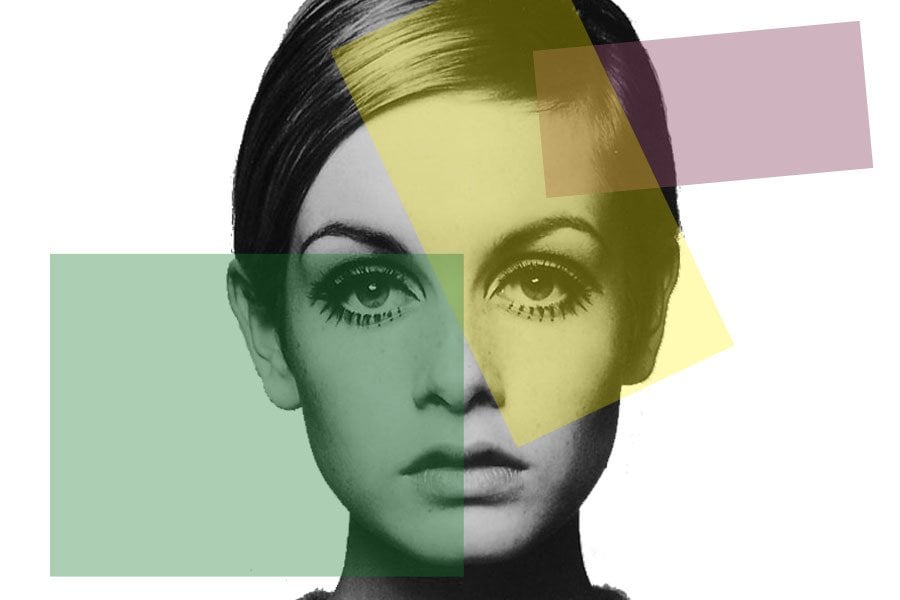Let’s roll back to 1966. Labour is in power with a majority of 96 seats, the Beatles are at the top of the charts with Paperback Writer, and Twiggy has been named the face of the year by the Daily Express. Best known for her petite frame, androgynous haircut and startlingly long eyelashes, Twiggy—real name Lesley Lawson (née Hornby)—was effectively England’s first supermodel. Discovered in a hairdressing salon after modelling for the new—and what would become her signature—cropped look, this skinny 16-year-old went on to take the fashion world by storm.
Twiggy’s success—and prolonged success at that—marked a turning point in fashion history. Previously, modelling had been regarded simply as the act of displaying clothes, makeup or hairstyles on an aesthetically pleasing figure. But Twiggy opened up a whole new dimension of modelling; the cult of the personality. Fans didn’t just obsess over the clothes she wore, or the way she drew on her eyelashes (although these certainly did garner a great deal of fascination)—they adored the girl in the dress, the person under the kohl. Her huge eyes sparkled with curiosity, intelligence and ambition. She wasn’t just a mannequin.
Despite retiring from modelling in 1970, Twiggy maintained her celebrity status and went on to become an award-winning actress and singer, famously playing the leading role in Ken Russell’s adaptation of musical The Boy Friend and released a plethora of successful music albums. The public have not lost their fascination even today; more recently Twiggy has partnered with Marks & Spencer to create a popular collection, and she has also generated her own style blog, where she discusses her HSN clothing line “Twiggy London”, remaining at the forefront of fashion journalism.
While Twiggy may have started the trend of Models as more than just the clothes they showcase, it certainly hasn’t ended with her. Today, it is hard to find a model who isn’t pursuing other paths or promoting bigger causes. Take Karlie Kloss; first discovered at the age of 14, she went on to walk an astounding number of catwalks during New York Fashion Week before becoming a successful Victoria’s Secret Angel and featuring on the cover of Vogue. In more recent years she has branched out, leaving behind her high fashion past to partner with chef Christian Tosi creating ‘Karlie’s Kookies’. She has also successfully founded ‘Kode with Klossy’, a training camp that aims to empower girls to learn to code and pursue careers in technology and computer science. In her words, “After experiencing the power of code myself, I knew I had to do my part to help girls know they could pursue it, too.”
Karlie is not the only one using her platform to promote other causes. Ashley Graham, the first size 14 model to appear on the cover of Sports Illustrated, is a leader of the body positivity movement and has collaborated with Addition Elle, Dressbarn and swimsuitsforall to create various clothing, lingerie and swimwear collections. Similarly, 5ft8 model Adwoa Aboah—currently on the cover of i-D and Love magazines—has founded an initiative called ‘Gurlstalk’. The website claims, “We are working together to create a community of girls from all different backgrounds, looking beyond external differences, and focusing on the essence of what it means to be a girl in the 21st Century.” The Gurlstalk Instagram combines behind-the-scenes fashion and lifestyle shots with everyday accounts of depression, anxiety and other mental illnesses, helping to raise awareness of and normalise the presence of mental illness in today’s society.
It’s clear that just being a pretty face won’t cut it anymore. Models such as Karlie Kloss, Ashley Graham and Adwoa Aboah—building on the work of their predecessors—have set a precedent for the girl-empowering, initiative-founding, barrier-breaking, more-than model. Using the tool of social media, these women have exploited the platform they have been given to draw attention to real, everyday issues that affect them and their generation. By using their fame for good, these catwalk and social media stars are changing the face of modelling and altering fashion history as we know it, proving that you can be beautiful and intelligent, striking and high-achieving, famous and ultimately, very real. After all, as Twiggy said, “You can’t be a clothes hanger for your entire life!”



